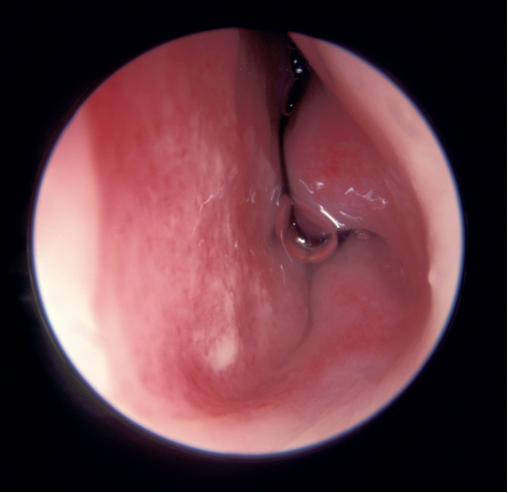Rhinorrhoea
Flowchart
Red flags
Unilateral serosanguinous nasal discharge may rarely be due to sinonasal malignancy. There are usually other associated symptoms such as pain and nasal obstruction. Refer via cancer-wait pathway to head and neck surgery.
Common pitfalls
Nasal polyps are not commonly visible on anterior rhinoscopy. More often, you are seeing a hypertrophic inferior turbinate. The inferior turbinate arises from the lateral nasal wall and is pink-red.
Regular, long-term use of an intranasal steroid spray is the mainstay of managing almost all nasal inflammatory disease. Patients must be made aware that these are long-term daily medications, and not to expect results before 6-8 weeks of use. Systemic absorption of intranasal fluticasone and mometasone is negligible - continue long-term if effective.
Sinus tenderness is of no clinical value in diagnosis.
History
When did the discharge start?
Is it clear or coloured? Does it smell bad? (coloured discharge suggests CRS)
Is it triggered by pollen or dust? (suggests allergic rhinitis) Or changes in temperature/bright light? (suggests autonomic rhinitis)
Is it one or both sides? Or does it alternate?
Associated nasal blockage?
Do you have a reduced sense of smell? (suggests CRS)
Do you have sneezing, itching or itchy, watery eyes? (suggests allergic rhinitis)
Are your symptoms worse at any time of the year or time of the day?
Have you had any operations on your nose in the past or any head trauma?
What treatments have you tried so far?
Occupation
Smoking or cocaine use
Examination
Inspection
Patients with allergic disease can occasionally have classical signs such as dark circles and an “allergic crease” across the nose.
Internal examination
Complete examination of the nose in rhinorrhoea requires an endoscope.
However, using an otoscope, or a headlight and a Thudichum speculum, look for:
Hypertrophic, oedematous mucosa suggestive of rhinitis (or CRS)
Septal perforation
Mucopurulent secretions
Normal nasal
cavity
and a
septal spur
Which nostril is this?
o Boggy, moist nasal mucosa and oedematous inferior turbinates typical of rhinitis:
Rhinitis
o Occasionally, mucopus or polyposis may be visible, indicating chronic rhinosinusitis (usually these are not visible without an endoscope):
Nasal Polyp
Differential diagnosis
Chronic rhinosinusitis (CRS) +/- nasal polyps
Syndrome of chronic inflammation of the nose and paranasal sinuses. The four key symptoms of CRS are nasal obstruction, rhinorrhoea, reduced smell and facial pain.
First line treatment is regular nasal fluticasone or mometasone spray (for at least 3 months), plus regular saline irrigation. If effective, continue long term. Consider a short course of prednisolone +/- antibiotics at start of treatment if symptoms are severe.
If first-line treatment is not effective, refer routinely to ENT/rhinology.
Rhinitis
Chronic nasal cavity inflammation: either allergic or non-allergic (idiopathic, autonomic, hormonal etc). Patients usually have rhinorrhoea with bilateral/alternating nasal congestion, but may have rhinorrhoea alone. Allergic rhinitis is more strongly associated with clear rhinorrhoea, sneezing, itching or an atopic background.
In mild allergic-type symptoms without significant nasal blockage, consider a second-generation antihistamine with or without nasal saline irrigation.
In moderate symptoms (especially if congested), start fluticasone/mometasone nasal spray for at least a 3-month trial. Consider also giving oral AH if prominent sneezing/itching.
Dymista nasal spray (fluticasone + azelastine) is second-line for allergic rhinitis, if patients do not respond to first-line steroid sprays.
Autonomic rhinitis commonly causes clear (bilateral) rhinorrhoea in the elderly patient. It is exacerbated by changes in temperature and environment, particularly during mealtimes. Try ipratropium bromide spray PRN (unless the patient has glaucoma). If this fails, consider a referral to rhinology as some patients benefit from surgery.
CSF rhinorrhoea
CSF rhinorrhoea is perfectly clear, watery and salty to taste. It is usually unilateral.
A CSF leak may occur spontaneously (e.g. idiopathic intracranial hypertension), or secondary to endoscopic transnasal surgery or head injury.
There is no indication for prophylactic antibiotics. Refer urgently to rhinology or neurosurgery, and if possible, confirm the diagnosis by sending a sample for beta-trace/tau protein. Consider the need for vaccination to prevent meningitis.
Management in primary care/when to refer
Refer any patient with unilateral blockage and serosanguinous rhinorrhoea via the cancer wait pathway.
Rhinitis and chronic rhinosinusitis are diagnosed on the basis of symptoms. It is reasonable to start all patients suspected of having an inflammatory or allergic nasal condition on a trial of a regular daily intranasal steroid spray (fluticasone or mometasone) for a three-month trial, before re-evaluating the need for referral. Antihistamines are of adjunctive benefit if there are allergic symptoms (sneezing, itching, clear rhinorrhoea).
Patients with a known history of chronic rhinosinusitis, who are still symptomatic despite good compliance with regular intranasal steroids, should be referred for consideration of endoscopic sinus surgery.
Current evidence and guidelines
Chronic rhinosinusitis: EPOS European Position Paper on Rhinosinusitis and Nasal Polyposis 2020
In patients with allergic rhinitis and asthma, consider referring to the Allergic Rhinitis and its Impact on Asthma (ARIA) Guidelines 2010
Authors
Mr Elliot Heward, ENT Registrar, North West Deanery
Mr Thomas Jacques, Consultant Rhinologist/ENT Surgeon, St. George’s Hospital, London



